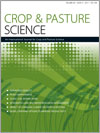CP16420Effect of VRN1 and PPD1 genes on anthesis date and wheat growth
PPD1 and VRN1 genes are known to be regulatory genes, influencing plant traits in addition to phasic development. We found epistatic effects of PPD1 and VRN1 genes on anthesis date, however only Vrn-B1 had an effect on crop growth. We suggest this is a pleiotropic effect of Vrn-B1 rather than a physiological association between wheat development and growth.




